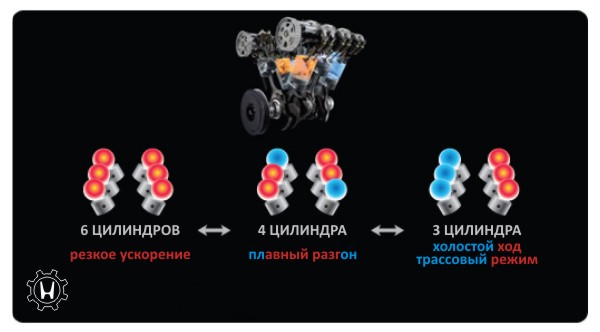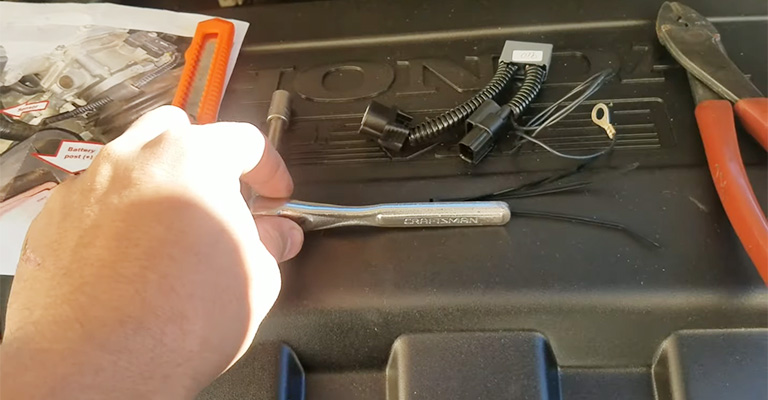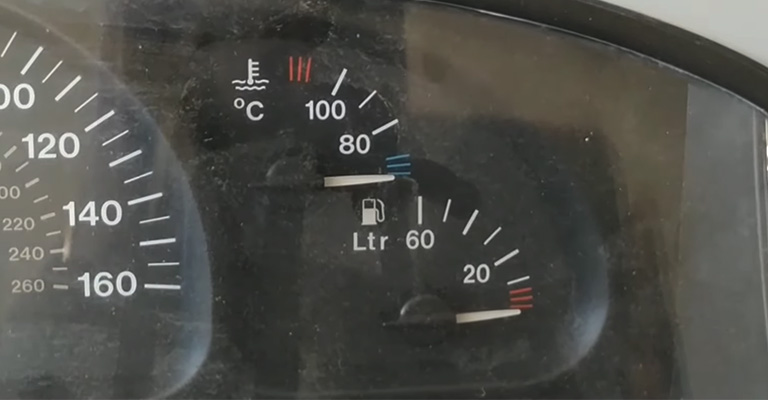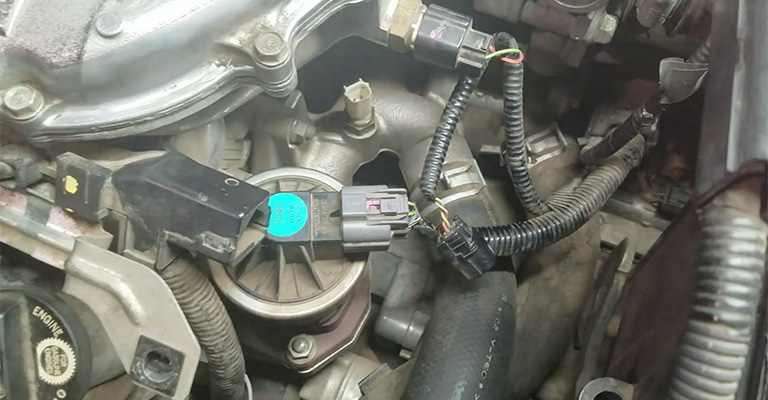From Wikipedia, the free encyclopedia
Variable Cylinder Management (VCM) is Honda’s term for its variable displacement technology, which saves fuel by using the i-VTEC system to disable one bank of cylinders during specific driving conditions—for example, highway driving. The second version of VCM (VCM-2) took this a step further, allowing the engine to go from 6 cylinders, down to 4, and further down to 3 as the computer sees fit. The most recent version of VCM (VCM-3) reverted to the previous 3- and 6-cylinder operation.
Unlike the pushrod systems used by DaimlerChrysler’s Multi-Displacement System and General Motors’ Active Fuel Management, Honda’s VCM uses overhead cams. A solenoid unlocks the cam followers on one bank from their respective rockers, so the cam follower floats freely while the valve springs keep the valves closed. The system operates through controlling the flow of hydraulic engine oil pressure to locking mechanisms in the cam followers. The engine’s drive by wire throttle allows the engine management computer to smooth out the engine’s power delivery, making the system nearly imperceptible on some vehicles. When the VCM system disables cylinders, an «ECO» indicator lights on the dashboard, Active Noise Cancellation (ANC) pumps an opposite-phase sound through the audio speakers to reduce cabin noise, and Active Control Engine Mount (ACM) systems reduce vibration.
The VCM hydraulic circuit control is defaulted open, meaning that the engine has to build up enough oil pressure on initial startup to disable the rear bank of cylinders. A single solenoid on the rear camshaft is activated to close oil pressure to unlock the cam followers, thereby closing the valves. In theory, the closing of all rear bank valves produces an ‘air spring’ effect. However, the reciprocating effect of the piston with closed valves reportedly produces a vacuum condition where oil can get pulled past the piston rings to flood the cylinder. When VCM disengages, the engine then misfires if needing to clear the cylinder of oil. This unique type of oil consumption has led to premature failure of parts like spark plugs, catalytic converters, engine mounts, pistons/rings, and cylinder walls. Newer versions of VCM have been developed to improve system reliability but consumers continue to log complaints.[citation needed]
Owners of vehicles equipped with VCM frequently face vibration problems due to engine motor mount malfunction while ECO mode is enabled.[1] Instead of replacing motor mounts, owners often override the VCM with a bypass mechanism, such as an in-line resistor based temperature override module. This has the effect of the vehicle computer believing that a sufficient engine temperature to enable VCM has not been reached. While this cannot guarantee that VCM will be disabled (e.g. differing climates/load scenarios), it can generally keep VCM from engaging under normal driving conditions. More advanced VCM disabler systems include a variable-resistance potentiometer[2] or a microcontroller[3] to manually or automatically adjust the resistance according to different conditions, which makes it possible to fully disable the VCM system, though at a somewhat higher cost.
Vehicles equipped with VCM[edit]
- 2003 Honda Inspire
- 2004+ Honda Elysion V6
- 2005–2007 Honda Accord Hybrid (JNA1)
- 2005-10 Honda Odyssey (USDM) — EX-L and Touring Models only (J35A7) — 2005-2007 models are equipped with VCM-1 (3- and 6-cylinder operation) — 2008-2010 models are equipped with VCM-2 (3-, 4-, and 6-cylinder operation).
- 2011+ Honda Odyssey (USDM) — 2011-2017 models are equipped with VCM-2 (3-, 4-, and 6-cylinder operation) — 2018+ models are equipped with VCM-3 (3- and 6-cylinder operation).
- 2006–2008 Honda Pilot 2WD Models only (J35Z1) — VCM-1 (3- and 6-cylinder operation)
- 2008–2017 Honda Accord V6 (except EX-L V6 6MT Coupe) — 2008-2012 models are equipped with VCM-2 (3-, 4-, and 6-cylinder operation) — 2013-2017 models are equipped with VCM-3 (3- and 6-cylinder operation).[4]
- 2009+ Honda Pilot (all models) — 2009-2015 models are equipped with VCM-2 (3-, 4-, and 6-cylinder operation) — 2016+ models are equipped with VCM-3 (3- and 6-cylinder operation).
- 2010-2014 Acura TSX (V6)
- 2013 Acura RDX V6
- 2013 Acura RLX — VCM-3 (3- and 6-cylinder operation)
- 2014 Acura MDX — VCM-3 (3- and 6-cylinder operation)
- 2015 Acura RLX Sport Hybrid — VCM-3 (3- and 6-cylinder operation)
- 2016-2020 Acura TLX V6
- 2017 Honda Ridgeline
See also[edit]
- Chrysler’s Multi-Displacement System (MDS)
- Daimler AG’s Active Cylinder Control (ACC)
- General Motors’ Active Fuel Management (AFM)
- Variable displacement
References[edit]
- ^ «Vibration on ECO mode». www.odyclub.com. Retrieved 2018-04-12.
- ^ «HOW IT WORKS». VCMTUNER. Retrieved 2023-11-18.
- ^ «S-VCM Controller — Disable VCM / deactivate VCM and stop ECO in Honda Acura». www.svcmcontroller.com. Retrieved 2023-11-18.
- ^ «Temple of VTEC Rumors and News — All-New 2013 Honda Accord Brings Remarkable Levels of Luxury, Agility, Efficiency and Sophistication».
External links[edit]
- CanadianDriver article
- Honda Worldwide | Technology Picture Book | VCM
VCM — (Variable Cylinder Management) функция бортового компьютера, отвечающая за подачу топлива и искры в цилиндры двигателя, и управляющая этим процессом. Создана для экономии топлива в шестицилиндровых двигателях большого объема (свыше 2,5 литров).
В зависимости от стиля езды, топливо и искра могут подаваться как во все шесть цилиндров (например при резком разгоне), так и в 4 из шести (при плавном) или только в 3 из 6, при езде накатом, на холостых оборотах, или при езде с постоянной скоростью по трассе.
Наглядная схема работы системы VCM
Если вы нашли ошибку, пожалуйста, выделите фрагмент текста и нажмите Ctrl+Enter.
Еще интересные статьи
Variable Cylinder Management (VCM) is Honda’s term for its variable displacement technology, which saves fuel by using the i-VTEC system to disable one bank of cylinders during specific driving conditions—for example, highway driving. The second version of VCM (VCM-2) took this a step further, allowing the engine to go from 6 cylinders, down to 4, and further down to 3 as the computer sees fit. The most recent version of VCM (VCM-3) reverted to the previous 3- and 6-cylinder operation.
Unlike the pushrod systems used by DaimlerChrysler’s Multi-Displacement System and General Motors’ Active Fuel Management, Honda’s VCM uses overhead cams. A solenoid unlocks the cam followers on one bank from their respective rockers, so the cam follower floats freely while the valve springs keep the valves closed. The system operates through controlling the flow of hydraulic engine oil pressure to locking mechanisms in the cam followers. The engine’s drive by wire throttle allows the engine management computer to smooth out the engine’s power delivery, making the system nearly imperceptible on some vehicles. When the VCM system disables cylinders, an «ECO» indicator lights on the dashboard, Active Noise Cancellation (ANC) pumps an opposite-phase sound through the audio speakers to reduce cabin noise, and Active Control Engine Mount (ACM) systems reduce vibration.
The VCM hydraulic circuit control is defaulted open, meaning that the engine has to build up enough oil pressure on initial startup to disable the rear bank of cylinders. A single solenoid on the rear camshaft is activated to close oil pressure to unlock the cam followers, thereby closing the valves. In theory, the closing of all rear bank valves produces an ‘air spring’ effect. However, the reciprocating effect of the piston with closed valves reportedly produces a vacuum condition where oil can get pulled past the piston rings to flood the cylinder. When VCM disengages, the engine then misfires if needing to clear the cylinder of oil. This unique type of oil consumption has led to premature failure of parts like spark plugs, catalytic converters, engine mounts, pistons/rings, and cylinder walls. Newer versions of VCM have been developed to improve system reliability but consumers continue to log complaints.[citation needed]
Owners of vehicles equipped with VCM frequently face vibration problems due to engine motor mount malfunction while ECO mode is enabled.[1] Instead of replacing motor mounts, owners often override the VCM with a bypass mechanism, such as an in-line resistor based temperature override module. This has the effect of the vehicle computer believing that a sufficient engine temperature to enable VCM has not been reached. While this cannot guarantee that VCM will be disabled (e.g. differing climates/load scenarios), it can generally keep VCM from engaging under normal driving conditions. More advanced VCM disabler systems include a variable-resistance potentiometer[2] or a microcontroller[3] to manually or automatically adjust the resistance according to different conditions, which makes it possible to fully disable the VCM system, though at a somewhat higher cost.
Vehicles equipped with VCM
edit
edit
- 2003 Honda Inspire
- 2004+ Honda Elysion V6
- 2005–2007 Honda Accord Hybrid (JNA1)
- 2005-10 Honda Odyssey (USDM) — EX-L and Touring Models only (J35A7) — 2005-2007 models are equipped with VCM-1 (3- and 6-cylinder operation) — 2008-2010 models are equipped with VCM-2 (3-, 4-, and 6-cylinder operation).
- 2011+ Honda Odyssey (USDM) — 2011-2017 models are equipped with VCM-2 (3-, 4-, and 6-cylinder operation) — 2018+ models are equipped with VCM-3 (3- and 6-cylinder operation).
- 2006–2008 Honda Pilot 2WD Models only (J35Z1) — VCM-1 (3- and 6-cylinder operation)
- 2008–2017 Honda Accord V6 (except EX-L V6 6MT Coupe) — 2008-2012 models are equipped with VCM-2 (3-, 4-, and 6-cylinder operation) — 2013-2017 models are equipped with VCM-3 (3- and 6-cylinder operation).[4]
- 2009+ Honda Pilot (all models) — 2009-2015 models are equipped with VCM-2 (3-, 4-, and 6-cylinder operation) — 2016+ models are equipped with VCM-3 (3- and 6-cylinder operation).
- 2010-2014 Acura TSX (V6)
- 2013 Acura RDX V6
- 2013 Acura RLX — VCM-3 (3- and 6-cylinder operation)
- 2014 Acura MDX — VCM-3 (3- and 6-cylinder operation)
- 2015 Acura RLX Sport Hybrid — VCM-3 (3- and 6-cylinder operation)
- 2016-2020 Acura TLX V6
- 2017 Honda Ridgeline
See also
edit
edit
- Chrysler’s Multi-Displacement System (MDS)
- Daimler AG’s Active Cylinder Control (ACC)
- General Motors’ Active Fuel Management (AFM)
- Variable displacement
References
edit
edit
- ^ «Vibration on ECO mode». www.odyclub.com. Retrieved 2018-04-12.
- ^ «HOW IT WORKS». VCMTUNER. Retrieved 2023-11-18.
- ^ «S-VCM Controller — Disable VCM / deactivate VCM and stop ECO in Honda Acura». www.svcmcontroller.com. Retrieved 2023-11-18.
- ^ «Temple of VTEC Rumors and News — All-New 2013 Honda Accord Brings Remarkable Levels of Luxury, Agility, Efficiency and Sophistication».
External links
edit
edit
- CanadianDriver article
- Honda Worldwide | Technology Picture Book | VCM
-
#1
VCM . Принцип работы , описание
Двигатель Honda 3.5 VCM ( Variable Cylinder Management), оснащенный интеллектуальной системой i-VTEC, работает по принципу использования части мощности на разных крейсерских скоростях. Система электрически деактивирует цилиндры для снижения расхода топлива. Двигатель Honda, оснащенный системой VCM , может работать на 3, 4 или 6 цилиндрах, таким образом, двигатель как бы делится на два: мощный, тяговитый для резких ускорений и передвижению по холмистой местности и маленький для экономичности при спокойной плавной езде.
Напомним, что двигатель Honda 3,5 V6, оснащенный системой VCM, устанавливается на последнее поколение Honda Pilot и Honda Crosstour.
Принцип работы .
Режим V6.
Когда необходима максимальная мощность и тяга (крутящий момент) работают все 6 цилиндров. Переход между тремя режимами (V6 , V4, V3) осуществляется почти незаметно для водителя и пассажиров.
Режим V4.
При крейсерской скорости, при ее увеличении двигатель переходит из режима v6 или v3 в режим работы четырех цилиндров. Система Active Engine Mounts помогает следить за вибрациями, идущими в салон.
Режим V3
При спокойной равномерной езде (при небольших скоростях) для еще большей экономии топлива отключается задний блок цилиндров. В этом режиме работает система Active Sound Control, она позволяет избавиться от нежелательных шумов.
[youtube]http://www.youtube.com/watch?v=rPzWutTfiQM[/youtube]
Honda engines have a legendary reputation across the globe for their performance and reliability. Fuel mileage could be an issue with Honda engines, but Honda fights the problem with its proprietary VCM technology.
So, what is VCM on a Honda? VCM stands for Variable Cylinder Management. It is a variable displacement system where a specific number of cylinders can be cut off when necessary. As a result, ride comfort and fuel mileage increase notably.
This guide will discuss the ins and outs of Honda’s VCM technology to give you a complete idea of how the system works. Let’s begin.
Table of Contents
Six-cylinder engines from Honda have i-VTEC technology to improve the performance of the engine. i-VTEC means Variable Valve Timing and Electronic Lift Control. This technology works in conjunction with the VCM to ensure optimal engine operation under different conditions.
For example, when you accelerate a Honda vehicle or drive it uphill, it requires the maximum power output from the engine. In such cases, all six cylinders are operating to deliver the required power.
But when you are driving on a leveled highway and have a moderate cruising speed, the full potential of the engine isn’t required. So, the VCM then turns off two or three cylinders based on multiple parameters. As a result, the engine produces the necessary power to cruise smoothly without sucking excess fuel.
Engines with the VCM can run in two configurations. They are
- Four cylinders on and two cylinders off
- Three cylinders on and three cylinders off
The onboard computer takes data from various sensors to calculate engine speed, vehicle speed, engaged gear, throttle position, and other parameters. Then, the ECU decides which cylinder to turn off depending on the driving condition. There are several benefits to having VCM on your Honda vehicle.
What Are the Benefits of VCM on a Honda?
Here is a quick overview of the benefits you get from a Honda engine with VCM.
- As all cylinders aren’t fired at cruising speeds, the fuel economy of the vehicle increases. The VCM can increase fuel economy by 10%
- When three or four cylinders are on, it produces a lot less noise and vibration than all cylinders running. So, the ride comfort increases with the VCM
- Running fewer cylinders means proportionally lower emissions. So, the vehicle spits fewer harmful elements into the environment
- By turning specific cylinders off, VCM decreases regular wear and tear on engine components. It increases the lifespan of the engine
What Are the Common VCM Problems?
Honda developed the VCM system over almost two decades. And vehicles produced between 2008 and 2013 seemed to have some issues with the VCM. As a result, Honda even faced a lawsuit in 2013. Some common problems of VCM are mentioned below.
Lower Fuel Efficiency
Though the VCM is designed to improve the fuel efficiency of your vehicle, some vehicles face decreased fuel efficiency due to VCM problems. The oil consumption of faulty vehicles rose by 1 quart, according to data based on about 1.6 million Honda vehicles worldwide.
Engine Misfiring
As some cylinders are shut off during cruising speeds from 30 to 70 miles per hour, the VCM needs to fire them up when needed. Some vehicles have faced misfiring due to faulty VCM. As a result, the engine loses its power.
Gear Slippage
It is another common problem with Honda vehicles having VCM. The VCM might miscalculate the parameters for engaging or disengaging cylinders, which causes gear slippage. Sometimes, shifting gears becomes too harsh on vehicles with a faulty VCM.
Can I Disable VCM on a Honda?
Only the models produced in 2013 and afterward have VCM-3, which provides a switch to disable VCM. But prior models have no built-in system for disabling the VCM. So, many users tried to disable the system using VCM disablers.
These disablers are usually OBD-II devices that you need to plug into the vehicle. After plugging in, the device manipulates the ECU to project a lower RPM. As a result, the ECU disables VCM right away. You can also use resistor kits to disable VCM on a Honda.
A resistor kit works by sending a lower voltage than required to the solenoid. As a result, the VCM gets disabled.
What Happens After Disabling VCM?
Once you disable VCM on your vehicle, fuel consumption increases drastically. As all cylinders are fired up regardless of driving conditions, the engine noise will also rise. And you will feel increased vibration inside the cabin after disabling the VCM.
The problems regarding vibration and noise may intensify just after disabling the VCM. Over time, these problems seem to be reduced as the engine gets used to normal operation. Keeping the engine maintained will also solve these problems to some extent.
FAQs
We answered some commonly asked questions regarding VCM. Check them out.
How do I know if my Honda has VCM?
Vehicles with V-type engines usually have VCM. You can confirm it by checking the VCM badge on the vehicle.
Does disabling VCM voids the warranty?
A: Yes, forcefully disabling the VCM might affect the transmission system of the vehicle. So, it will void the transmission warranty.
Does VCM cause vibration?
VCM actually helps reduce vibration on Honda engines. But if the motor mount of the engine isn’t working properly due to a faulty VCM, the vibration can increase.
Conclusion
To wrap up the discussion, let’s recap what is VCM on a Honda. VCM or Variable Cylinder Management is a technology to make the engine more efficient while reducing oil consumption. When the engine’s full potential isn’t required, VCM shuts off two or three cylinders to increase the fuel efficiency of the vehicle. I
t has several benefits, but some problems also occur in vehicles with faulty VCM. So, you might consider disabling VCM using third-party devices. That also has its consequences, such as increased vibration or noise and poor fuel economy.
VCM (Variable Cylinder Management) is fuel-saving technology that automatically deactivates 1/3 or 1/2 of the cylinders, according to the driving conditions. This saves fuel and lowers emissions.
Why do Hyundai engines fail?
The piston rings may not have been properly heat-treated, which can cause engine damage, oil leaks and possible fires. Hyundai says the rings can be too hard and can be chipped, scuffing the engine cylinder. The piston problem has caused five fires but no injuries, according to documents.
Does Honda still use VCM?
VCM3 (the most current version) has been in use various Honda and Acura products since 2015 – the Odyssey was actually one of the last V6-equipped models to get it in 2018.
What is VCM actuator?
Voice Coil Motors (VCM), also called Voice Coil Actuators (VCA), are a very mature design that utilizes a magnet and yoke in conjunction with a coil. The interaction between the coil’s magnetic field and the magnetic field in the gap is what gives rise to the linear force acting on the coil.
Which Honda engines have VCM?
Vehicles equipped with VCM 2008–2017* Honda Accord V6 (except EX-L V6 6MT Coupe) *Starting with 2013 Model, VCM operation is 3- or 6-cylinder mode, no longer 3, 4, 6-cylinder operation.
Can Honda dealership disable VCM?
The operating temperature of the vehicle is unchanged and all data is within OBD-II limits as normal operation for the vehicle when properly installed and setup according to the users manual,, Honda does not officially endorse any method to disable VCM at this time.
What is VCM lens?
Voice Coil Motors (VCM), also called Voice Coil Actuators (VCA), are a very mature design that utilizes a magnet and yoke in conjunction with a coil. Because the coil is the only moving component, they allow for both high-speed motion and accurate positioning. It’s typically used as the camera’s focus function.
How does the VCM work on a Hyundai Elantra?
It consists of a DC motor which actuates the VCM valve and a position sensor which detects the position of the VCM valve. The VCM system tumbles air flow entering into combustion chamber of each cylinder by closing the VCM valve in the cold start conditions. • Install the component with the specified torques.
How does the VCM work in a car?
The VCM system tumbles air flow entering into combustion chamber of each cylinder by closing the VCM valve in the cold start conditions. This tumble effect reduces cold start emissions by improving atomization.
Where can I buy a Hyundai Motor Assembly?
To ensure reliability, purchase Hyundai part # 28323-2GGA1 MOTOR ASSEMBLY-VCM . Our Hyundai parts and accessories are expedited directly from authorized Hyundai dealers strategically located all across the U.S. and are backed by the manufacturer’s 12 month, 12,000 mile warranty.
How does the VCM work on a Kia Forte?
It consists of a DC motor which actuates the VCM valve and a position sensor which detects the position of the VCM valve. The VCM system tumbles air flow entering into combustion chamber of each cylinder by closing the VCM valve in the cold start conditions.





